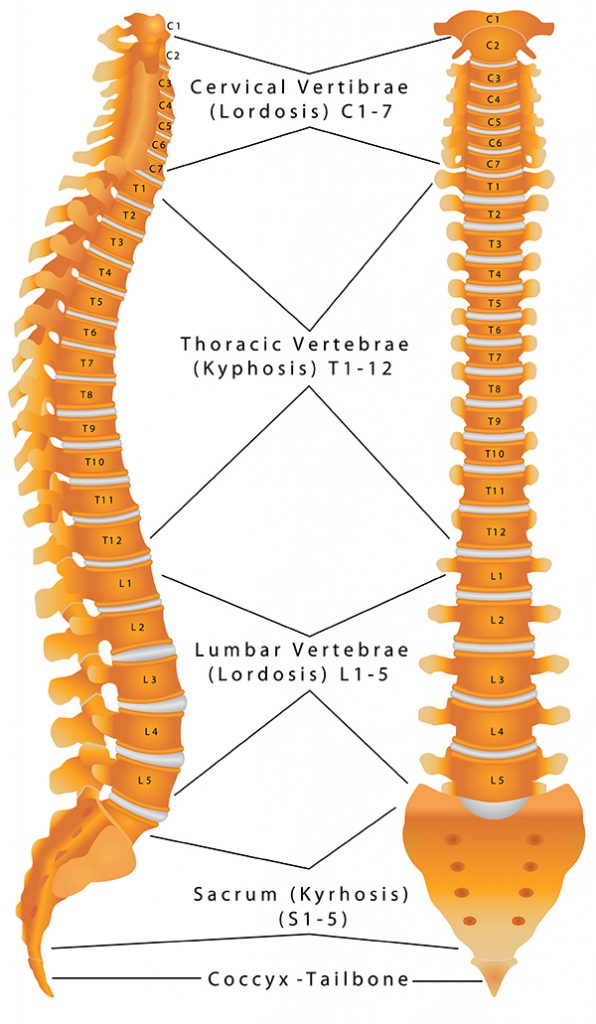Spine
The Spinal Column
About the Typical Vertebra
The typical human spinal column consists of 33 vertebrae, most of which are connected by joints. Your spine also has nine
vertebrae in the sacrum and the coccyx or tailbone that are fused together. The spine or the vertebral column is located in the back of the trunk or the torso. In between each pair of vertebrae in the spine, other than those that are fused, lies an intervertebral disc that separates the backbones and provides cushioning. These discs help absorbs the vibrations and shock that occur every time you move. The spinal cord is located within the protective spinal canal of the spine.
The spine normally consists of 33 vertebrae. This includes the 5 sacral vertebrae (the solid part of the vertebra that joins the hip bone to form the human pelvis) and the 4 bones of the coccyx (tailbone). The upper 24 vertebrae are separated into three regions, the cervical, the thoracic and the lumbar regions.
 Typical vertebra divided and explained
Typical vertebra divided and explained
- Cervical: The cervical region of the spine is made up of the first 7 vertebrae found closest to the skull in the neck area. They are named C1 through to C7, beginning closest to the skull and continuing downward in consecutive order towards the end of the spinal column.
- Thoracic:
There are 12 thoracic vertebrae found in the chest and rib area of the spine. They are named T1 through to T12. T1 lies
next to C7, separated by an intervertebral disc. - Lumbar:
There are 5 lumbar vertebrae in the lower back and pelvic region of the spine, L1 through L5. L1 immediately follows T12 with an intervertebral disc separating the two.
In some cases of a typical vertebra, an additional vertebra is found in an area of the spine, or a vertebra is missing in one region and the deficiency is made up in another area. This happens very rarely, however, in this case, the number of cervical vertebrae is then altered.
Your spine is not completely straight. The curves in your back help to provide balance and they work with the intervertebral discs to help absorb the shock and stress that occur with movement.
The curve in the upper part of the spine (the cervical curve) is forward. This is typically the smallest curve of the spine. The thoracic curve, or the one in the middle section of the spine, curves backward. This is the curve that is exaggerated in a condition known as kyphosis.
Men have less lumbar curve than women in the lower spine. This is a forward curve and is sometimes called lordosis. The sacral curve is forward and also downward.
An infant is born with curves in the sacral and thoracic spine and these are known as primary curves. The lumbar and cervical curves are not present in the spine at birth. They develop as a child grows and are known as secondary curves. The cervical curve is gradually formed as an infant learns to hold up his head and sit without support. The lumbar curve develops later when the child starts to walk.
Typical vertebra deformities such as Kyphosis
Kyphosis, as mentioned earlier in this article, is an exaggerated curve of the back. There are types of Kyphosis namely:
- Osteoporosis Kyphosis
- Congenital Kyphosis
-
- Cerebral Palsy - affects movement, muscles and posture and many patients often cannot walk on their own. Cerebral palsy is often present at birth as the brain may not have developed completely.
-
- Muscular Dystrophy - a weakening of the muscles and loss of muscle mass from a young age and is more common in boys than girls.
- Spina Bifida - a birth defect where the spinal cord of the baby is not completely developed and it sometimes results in spinal fluid to push up against the skin of the back.
Other forms of Kyphosis include Scheuermann's Disease, Postural Kyphosis, Latrogenic Kyphosis, Traumatic Kyphosis and Nutritional Kyphosis.
- - Pain
- - Stiffness
- - Tingling
- - Numbness
- - Leg weakness
- - Difficulty breathing
- - Cardiac problems
- - Surgery
- - Pain medication
- - Physical therapy
- - Exercise
- - Weight control
- - The use of a back brace






